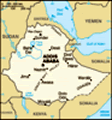Advertisement
Published: November 27th 2012
6th Nov ’12 Axum
Well I guess we were lucky as we slept through the night, unlike some of our group whose rooms faced town and heard the chanting competition! It turns out today is a special religious celebration day.
After breakfast we wandered out onto the terrace and got fantastic views across the little town and we could look down right over the stelae field.
Ok perhaps I should start by saying let me take you back……back into the days of the Old Testament, to the time of the Queen of Sheba, King Solomon, Menelik their son and the Ark of the Covenant, to the King of Ethiopia called Balthazar – think ‘we 3 kings of Orient are’, to piles of frankincense, half explored tombs, secret doorways, ruined palaces and fortresses, unearthed 4th century stone tablets covered in ancient writings and then the towering huge stone obelisks – the stelae, then perhaps you can imagine some of the sense of awe I felt at being in Axum!
Axum is the sacred capital of the Tigray region and is the birthplace of Christianity in Ethiopia. It was the Ethiopian Empires capital between the 1st and 10th centuries
AD and there is much recorded history which speaks of its prominence within the ancient world, and its trade links with Greece and the Arabian countries.
Sightseeing today started with the Queen of Sheba’s swimming pool which dates from about 1000 BC. It is a reservoir which is still regularly used by local people for washing from the steps and this was indeed going on when we were there. It is also used for the local Timkat celebrations.
Carrying on up the hillside we came to the site of archaeological excavations of some tombs. Going down the rock cut steps we were in a tomb area with about 3 small rooms where the coffins and treasures would have been placed. The graves had been robbed but when the dig took place small coins were still discovered.
All the rock blocks were hand cut and fitted together perfectly without any mortar. Most intriguing was the large stone slab which is thought to be a doorway into another tomb, chamber or passageway, oooooh I want to see beyond it!
On the way back to town we stopped at a small stone hut which didn’t look anything special until
you got inside. This is where the 4th century Ezna Stone lives, it is a large inscribed stone tablet found by a couple of farmers in 1981 and is the Ethiopian equivalent of the Rosetta Stone! It is carved in Sabaan (an old south Arabian language used in Yemen), Ge’ez (the ancient Ethiopian language) and Ancient Greek, so you can imagine its importance! Its’ discovery just highlights the wealth of ancient Ethiopian history that lies buried in the country just waiting to be discovered!
Then we were off to the main Stelae Field. The Stelae are giant carved stone obelisks that mark graves. The Obelisk of Axum is about 1,700 years old, 78 foot tall and weighs 160 tons and was taken to Italy during their occupation of the country (boo hissssss) and has only relatively recently been returned and re-erected.
There are six main large stelae and lots of smaller ones, some still standing and some not in this ‘field’ and lots of other smaller ones in various locations around the town. They are carved to look like multi storey buildings, with false windows and doors with knockers. At the top is an area where large discs
would have hung with inscriptions of who was buried there and their achievements.
While we were looking around the Coptic orthodox Christian service (which lasts two hours) was being broadcast over loud speakers. Suddenly we noticed everyone in the town and streets had just stopped still and gone silent. It turned out that at the point in the service where the bread and wine are transubtated had been reached and no-one moves or speaks until it is over, then they just carry on again, kind of like our 2 minute silences I guess but longer. It really had an impact on us and brought home to us just how important their religion is to their everyday life.
We had a quick look around the museum attached to this site which had some interesting displays and showed a good film about the ancient history and sites within Ethiopia.
Next we saw King Balthazar’s Tomb, he is believed to be one of the three kings who visited Jesus in the manager. Frankincense is everywhere in Ethiopia so that fits and Ethiopia was known in the bible as the Land of Punt – which means luxury things such as incense.
Again we went down into the tomb and saw the niche where his coffin had lain. There were also lots of other niches for coffins too. How amazing it was to think we were in the final resting place of one of the 3 Kings!!
The next mystical and intriguing stop was at the new St. Mary of Zion Church. This was a church built by Haile Selassie complete with a chandelier presented by Queen Elizabeth 11! It was a large, echoy and modernish building, there were some interesting old paintings showing the Ark of the Covenant being brought to Ethiopia and a fascinating old illustrated bible which the church deacon showed us and is kept wrapped up in old (presumably sacred) curtains.
This new church is build next to the older original St. Mary of Zion Church and in the area in between the two is the small chapel which is where the actual Ark of the Covenant is kept. One priest lives there and is the care taker of it and no-one else is allowed in at all. Once he dies another priest is elected to the position and so on and obviously it is
the highest honour to be selected.
The building doesn’t really look how I would have expected a place containing something so holy and sacred to look, but maybe that was the point, to protect it from invaders. It’s also in need of repair so a second chapel is being built next to it, the Ark will then be transferred at night in secrecy to it until the original chapel is repaired and then it will go back again.
Absolutely no-one else is allowed to enter the chapel or set eyes upon the Ark (partly due to its’ enormous powers). The story of how the Ark came to Ethiopia goes like this – The Queen of Sheba who lived in Axum journeyed to Jerusalem to visit King Solomon the wise, he had the ‘hots’ for her and eventually succeeded in tricking her into sleeping with him one night, a baby was conceived and on her way back to Ethiopia Menelik was born.
Menelik grew up in Ethiopia and when he was in his 20s he went to visit his father. He stayed with him for a long time and was a favoured son. Eventually court politics and jealousies
meant he decided to return to his home. King Solomon loved him and decreed that every first born noble’s son would accompany him back and live in Ethiopia.
Now it was these sons who decided they would take the Ark with them as they couldn’t leave their faith behind. So unbeknown to Menelik they stole it and brought it with them. Only when they were in Axum did they reveal what they had done. There were no reprisals from King Solomon and the story of the Ark kind of faded out of history. Perhaps this was deliberate, to stop Muslim invaders from finding, taking and using the Ark (like those Nazis in Raiders of the lost Ark!).
The nobles’ sons’ descendants are still living in Ethiopia, they are a tiny minority group known as the Falashar Jews. Whatever you make of it all I actually think the Ark is indeed here and I rather tremble and rejoice to think I have been so close to it!!
The church museum is a tiny but fascinating place stuffed full of a wealth of treasures, crowns, robes, crosses and so on. The church is building a new three storey museum
as most of their collection is hidden away and never seen at the moment. I bet that will be fantastic when it opens!
The blokes were then taken off to visit a monastery which women aren’t allowed in and we went back to the bus where more shopping took place. I gave a couple of blind people some money (its ok to give to people with disabilities who are begging near churches as the locals also do this) and I guess word got out and I ended up having to jump back on the bus to avoid the crowds of beggars who turned up!
Once we were all back on board our final stop was the ruins of the Queen of Sheba’s Palace. Now these really are just ruins, but we stood on a wooden platform over looking the site – with 4 young girls singing and trying to lure us to the wall to buy their goods, and the local guide explained the history of the Queen of Sheda, how the town was laid out at the time and where things would have been. I can’t go into it all in here so google it if you
are interested, but the upshot is the ruins we were looking at are believed to be that of a nobles house BUT they are build on far far old ruins which are thought to be those of the Queen of Sheba’s Palace. And you know what? I believe this is where it was and for those of you saying yes Melanie you would, actually so did Howard the sceptic too!
So another amazing day! My mind was boggled with it at the time and now looking back I just feel even more boggled, humbled, awe filled, tingly and tantalised by it all!
Archaeologists get out to Ethiopia now!! (and take me with you!)
Advertisement
Tot: 0.231s; Tpl: 0.014s; cc: 7; qc: 52; dbt: 0.1247s; 1; m:domysql w:travelblog (10.17.0.13); sld: 1;
; mem: 1.2mb




























